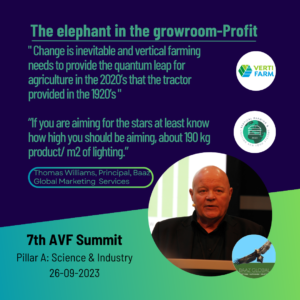Critics often emerge as passionate individuals driven by a genuine desire to see improvements in their field. One such individual, Thomas Williams, brings us a thought-provoking presentation entitled ‘The Elephant in the Growroom.’ While criticism can be irksome, Williams’ critical perspective stems from his passion for vertical farming and a strong commitment to its success.
Key Takeaways from the Presentation:
- Reality Check for Vertical Farming: Williams’ presentation is a wake-up call for the world of vertical farming, focusing primarily on the mass production of vertically farmed leaf lettuce and herbs. It sheds light on the struggles faced by even the biggest and most innovative farms, many of which have gone bankrupt.
- Profit: The Unspoken Challenge: The central theme of Williams’ presentation is the profitability challenge in vertical farming. Investors often overlook the reality when considering this industry. He emphasizes that making a profit is the most basic of all business sustainability rules.
- Competing in the Real World: Vertical farmers must recognize that they operate in the real world, facing competition from seasonal cheap imports, traditional field horticulture with massive investments, dominant processor groups, and knowledgeable food retail giants determined to maintain the status quo. We are challenging every one of these firmly entrenched entities and we must learn how to stand up against or assimilate, with them.
- The Path to Success: Vertical farmers must blend in-depth plant knowledge with efficient, cost-effective automation and sustainable energy sources to succeed operationally. On the business front, understanding the food supply chain is crucial, including decisions on selling to wholesalers, retailers, or consumers directly.
- Providing Comprehensive Solutions: Merely offering standalone technologies is insufficient for long-term success. Vertical farming businesses must provide customers with everything they need, including qualified advisors who understand both their technology and the market their clients wish to sell into.
- Calculating Costs and Yields: Costs, automation responsiveness, energy consumption, and labour requirements vary significantly across vertical farming facilities. Understanding these factors is essential for achieving profitability.
- The Challenge of Breakeven: Breakeven in vertical farming is estimated to be higher compared to greenhouse products. Even with a slight profit margin, vertical farmers must consider the impact and challenges of rising energy and labour costs.
- Surviving Competition: Vertical farmers face fierce competition from organic farmers, imported produce, traditional farmers, hydroponic greenhouses, and soil-based greenhouses. The risk of being squeezed out of business exists at every level.
- Changing Market Dynamics: While extended shelf life and pesticide-free produce offer economic benefits, their value in the real world is limited and diminishing. Niche markets quickly become crowded and unprofitable when competition enters.
- The Importance of Renewable Energy: Sustainability is questioned without 100% renewable energy sources. Having an independent energy source will future-proof one’s investment.
- Identifying Competitors: Vertical farming’s competitors are not just other vertical farms but also global giants in the food industry who understand their market and customers inside out.
- Attracting Investors: To attract investors, vertical farming ventures must align with patient investors if they are in the research and development phase or find off-takers who will commit to buying produce at competitive wholesale prices.
- Scientific Approach: Successful vertical farming systems are designed based on deep scientific growing principles built over decades, combined with the latest engineering in automation. It has taken decades for the leaders in the industry to become commercially viable when offering produce at commodity prices.
- Measuring Success: The presentation highlights metrics for marketable yield per square meter of land and lighting, providing a guide for growers and investors.
Conclusion:
Thomas Williams’ presentation, “The Elephant in the Grow Room”, forces us to confront the harsh realities of vertical farming. Success in this industry requires a profound understanding of plants, efficient automation, sustainable energy, and a deep knowledge of the market and competition. Vertical farmers must navigate challenges to not only break even but thrive in a highly competitive landscape. Only with a comprehensive approach can vertical farming truly flourish.:
Survey Results:
Williams’ presentation also includes valuable survey results that provide insights into the performance and standing of vertical farming in the global industry, particularly in the context of salad mix production. The surveys measured the following key metrics:
- Kg of Marketable Yield per m2 of Land: This metric represents the amount of produce that can be processed and bagged for retail and food service per square meter of farming space.
- Kg of Marketable Yield per m2 of Lighting: This metric gauges the efficiency of lighting usage in generating marketable yield per square meter.
Survey Findings:
- Open Field Farming: Traditional open field farmers yield approximately 4 kg of produce per square meter yearly.
- Soil-Based Greenhouses: Soil-based greenhouse growers achieve yields ranging from 14 to 25 kg per square meter per year, with variations depending on the location.
- Hydroponics with Natural Light: Hydroponic farming utilizing natural light within a greenhouse typically yields between 45 to 60 kg per square meter per year.
- Hydroponics with Supplemental Lighting: Highly efficient hydroponic farms with one-level well-managed and incorporating both natural and supplemental lighting can achieve impressive yields of 100 to 120 kg per square meter of lighting annually.
- Multi-Level Indoor Farms: Multi-level indoor farms face challenges, producing an average of 45 to 50 kilograms per square meter of lighting annually. With advanced knowledge of plant conditions related to lighting, some may improve to 60-80 kg per square meter of lighting per year.
- Top-Performing Indoor Farms: The most successful indoor farms, equipped with a deep understanding of variables like Vapor Pressure Deficit (VPD), reach remarkable yields of 90-110 kg per square meter of lighting per year.
- The Grass Ceiling: Baaz highlights the concept of a “grass ceiling,” which represents a ‘perceived upper limit’ in the minds of most vertical farmers. A few farms reach yields in the range of 125-127 kg of lettuce per square meter of light per year; however, there is one exceptional farm that has broken through this ‘grass ceiling’ with a remarkable 190 kg of marketable produce per m2 of light per year.

Conclusion:
In conclusion, Thomas Williams’ presentation, “The Elephant in the Growroom,” offers a stark look at the realities of vertical farming. Success in this industry demands a profound understanding of plants, efficient automation, sustainable energy, and a deep knowledge of the market and competition. Vertical farmers must navigate challenges to break even and thrive in a highly competitive landscape. The “grass ceiling” concept reveals that while many farms achieve impressive yields, there is room for exceptional performance.
It is encouraging to see that many respondents in the survey have surpassed breakeven, but it is equally disturbing to observe the significant variation in their costs. As existing wholesalers reduce prices, vertical farmers must brace themselves for tougher competition. The initial battle was relatively easy, but the second fight will be more challenging, and it’s only a blip on the radar of what’s to come.
Call to Action:
Change is inevitable, and vertical farming must be the quantum leap that the tractor was in the 1990s. Some vertical farms will succeed, while others may fade away, but change is undeniable. As the industry faces these challenges, it’s crucial for all stakeholders to adapt, innovate, and collaborate to ensure the future viability and success of vertical farming.
BY Isabelle van Doorn



Comments are closed.